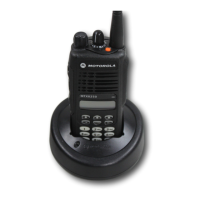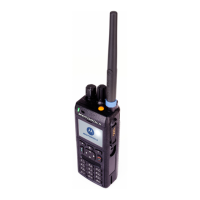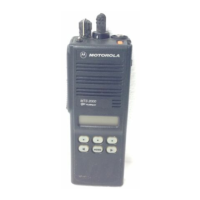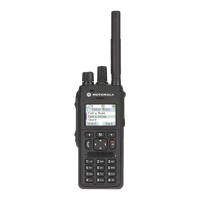Do you have a question about the Motorola MTX9250 and is the answer not in the manual?
General safety guidelines and operational advice for the two-way radio.
Explains how the radio generates and uses radio frequency energy during operation.
Guidelines for safe operation and exposure to radio frequency electromagnetic energy.
Proper procedures for wearing the radio on the body to comply with RF exposure guidelines.
Instructions for using and maintaining the radio's antenna.
Information on potential interference with other electronic devices.
Guidance on radio use in specific facilities like hospitals.
Regulations and instructions for using the radio on aircraft.
Precautions regarding pacemakers and other medical devices.
Critical warnings for safe operation in various environments.
Safety procedures for operating the radio in hazardous or explosive environments.
Safety precautions when operating near blasting caps or in blasting areas.
Cautions related to antennas, batteries, and general handling.
Information on equipment approved for use in hazardous locations.
Specific warnings for operating intrinsically safe equipment in hazardous atmospheres.
Guidelines and responsibilities for repairing intrinsically safe products.
Importance of using only approved accessories with intrinsically safe equipment.
Identifies and labels the physical components of the MTX8250 and MTX9250 radios.
Details the functions and character cycles of the radio's keypad.
Explains the operation of menu navigation keys.
Describes how to access and select radio features using the display and keys.
Explains the display indicators and status symbols on the radio's screen.
Describes the audible tones used to indicate radio operating conditions.
Information on customizing button functions for shortcuts.
Details on charging and managing the radio's battery.
Step-by-step guide for physically connecting the battery to the radio.
Instructions on how to detach the battery from the radio.
General information about radio accessories.
Procedure for connecting the antenna to the radio.
Procedure for detaching the antenna from the radio.
Instructions for securing the belt clip to the radio.
Instructions for detaching the belt clip from the radio.
How to power the radio on and off, including self-check procedures.
How to control the radio's audio output level.
Guide to choosing operating zones for different communication systems.
How to select specific communication channels or talkgroups.
Steps for initiating a call on a trunked radio system.
Steps for initiating a call on a conventional radio system.
How to listen for and receive calls on trunked and conventional systems.
How the radio operates during trunked system failures.
Explanation of PL, DPL, and carrier squelch for conventional channels.
How to use repeater or direct talkaround modes for communication.
Features for controlling transmissions using the Push-To-Talk button.
How to adjust the radio's transmission power level.
How to enable or disable audible feedback for keypad presses.
How to find and display the radio's unique identification number.
Features for private conversations with call status checking.
How to answer and manage incoming private calls.
Steps for initiating a private conversation with another radio.
How to receive and respond to group call alert pages.
How to send a call alert page to other radios.
Using the call alert feature as a pager.
How to enter and edit telephone numbers in the radio's list.
How to enter and edit radio ID numbers for call lists.
How to answer incoming telephone calls on the radio.
Steps for initiating a telephone call from the radio.
Basic procedures for operating the radio's scan feature.
How to enable or disable scanning using the radio's keypad.
Temporarily removing unwanted modes from the scan list.
How to check the contents of the radio's scan list.
How to configure which modes are included in the scan list.
Details the terms and duration of the product warranty.
General terms and conditions of the warranty agreement.
Information on consumer rights that may vary by state.
Steps to follow to obtain warranty service for the product.
Specifies exclusions and limitations of the warranty coverage.
Legal provisions related to patents and software used in the product.
Various cases available for carrying and protecting the radio.
Different types of headsets for discreet or hands-free communication.
External microphones with speaker functionality for easier use.
Adapters for connecting audio accessories.
Various earpiece options for private listening.
Different battery types and capacities available for the radio.
Available chargers for powering and recharging the radio's batteries.
Different antenna types for optimizing radio performance.
Description of an integrated audio communication device.
General safety guidelines and operational advice for the two-way radio.
Explains how the radio generates and uses radio frequency energy during operation.
Guidelines for safe operation and exposure to radio frequency electromagnetic energy.
Proper procedures for wearing the radio on the body to comply with RF exposure guidelines.
Instructions for using and maintaining the radio's antenna.
Information on potential interference with other electronic devices.
Guidance on radio use in specific facilities like hospitals.
Regulations and instructions for using the radio on aircraft.
Precautions regarding pacemakers and other medical devices.
Critical warnings for safe operation in various environments.
Safety procedures for operating the radio in hazardous or explosive environments.
Safety precautions when operating near blasting caps or in blasting areas.
Cautions related to antennas, batteries, and general handling.
Information on equipment approved for use in hazardous locations.
Specific warnings for operating intrinsically safe equipment in hazardous atmospheres.
Guidelines and responsibilities for repairing intrinsically safe products.
Importance of using only approved accessories with intrinsically safe equipment.
Identifies and labels the physical components of the MTX8250 and MTX9250 radios.
Details the functions and character cycles of the radio's keypad.
Explains the operation of menu navigation keys.
Describes how to access and select radio features using the display and keys.
Explains the display indicators and status symbols on the radio's screen.
Describes the audible tones used to indicate radio operating conditions.
Information on customizing button functions for shortcuts.
Details on charging and managing the radio's battery.
Step-by-step guide for physically connecting the battery to the radio.
Instructions on how to detach the battery from the radio.
General information about radio accessories.
Procedure for connecting the antenna to the radio.
Procedure for detaching the antenna from the radio.
Instructions for securing the belt clip to the radio.
Instructions for detaching the belt clip from the radio.
How to power the radio on and off, including self-check procedures.
How to control the radio's audio output level.
Guide to choosing operating zones for different communication systems.
How to select specific communication channels or talkgroups.
Steps for initiating a call on a trunked radio system.
Steps for initiating a call on a conventional radio system.
How to listen for and receive calls on trunked and conventional systems.
How the radio operates during trunked system failures.
Explanation of PL, DPL, and carrier squelch for conventional channels.
How to use repeater or direct talkaround modes for communication.
Features for controlling transmissions using the Push-To-Talk button.
How to adjust the radio's transmission power level.
How to enable or disable audible feedback for keypad presses.
How to find and display the radio's unique identification number.
Features for private conversations with call status checking.
How to answer and manage incoming private calls.
Steps for initiating a private conversation with another radio.
How to receive and respond to group call alert pages.
How to send a call alert page to other radios.
Using the call alert feature as a pager.
How to enter and edit telephone numbers in the radio's list.
How to enter and edit radio ID numbers for call lists.
How to answer incoming telephone calls on the radio.
Steps for initiating a telephone call from the radio.
Basic procedures for operating the radio's scan feature.
How to enable or disable scanning using the radio's keypad.
Temporarily removing unwanted modes from the scan list.
How to check the contents of the radio's scan list.
How to configure which modes are included in the scan list.
Details the terms and duration of the product warranty.
General terms and conditions of the warranty agreement.
Information on consumer rights that may vary by state.
Steps to follow to obtain warranty service for the product.
Specifies exclusions and limitations of the warranty coverage.
Legal provisions related to patents and software used in the product.
Various cases available for carrying and protecting the radio.
Different types of headsets for discreet or hands-free communication.
External microphones with speaker functionality for easier use.
Adapters for connecting audio accessories.
Various earpiece options for private listening.
Different battery types and capacities available for the radio.
Available chargers for powering and recharging the radio's batteries.
Different antenna types for optimizing radio performance.
Description of an integrated audio communication device.
| Brand | Motorola |
|---|---|
| Model | MTX9250 |
| Category | Portable Radio |
| Language | English |












